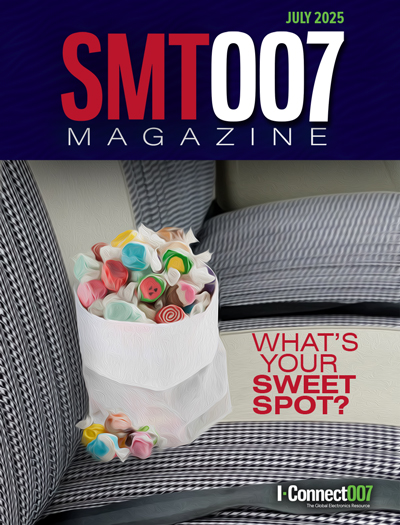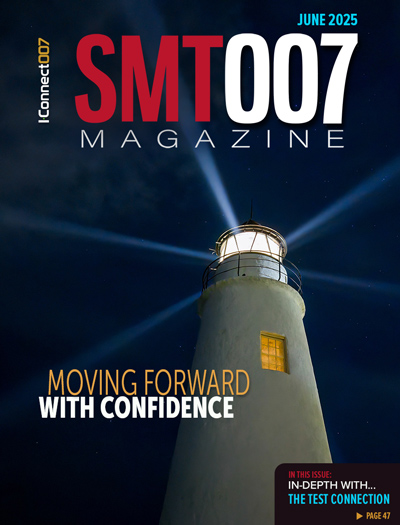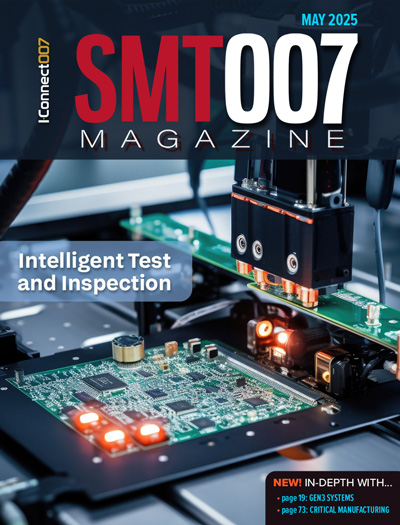-

- News
- Books
Featured Books
- smt007 Magazine
Latest Issues
Current Issue
What's Your Sweet Spot?
Are you in a niche that’s growing or shrinking? Is it time to reassess and refocus? We spotlight companies thriving by redefining or reinforcing their niche. What are their insights?

Moving Forward With Confidence
In this issue, we focus on sales and quoting, workforce training, new IPC leadership in the U.S. and Canada, the effects of tariffs, CFX standards, and much more—all designed to provide perspective as you move through the cloud bank of today's shifting economic market.

Intelligent Test and Inspection
Are you ready to explore the cutting-edge advancements shaping the electronics manufacturing industry? The May 2025 issue of SMT007 Magazine is packed with insights, innovations, and expert perspectives that you won’t want to miss.
- Articles
- Columns
- Links
- Media kit
||| MENU - smt007 Magazine
Nanotech Energy Launches EMI Shielding Product Line
October 6, 2020 | PR NewswireEstimated reading time: 2 minutes
Nanotech Energy Inc., a leading manufacturer of graphene, announces the debut of Nanotech EMI Armour Paint & Sheets, graphene powered coatings and films for electromagnetic interference (EMI) and radio frequency interference (RFI) shielding, as well as heat management. The EMI Shielding line currently contains six products – all of which are highly conductive and provide excellent external EMI/RFI protection while also preventing internal EMI/RFI leaks. The products can be sprayed, brushed, rolled or dip-coated onto various surfaces, such as glass, plastic and metal – depending on the specific product used.
Eco EMI Armour Paint
The Nanotech EMI shielding product line is based on the Company's premium graphene technology and consists of the following:
- Eco Armour Paint & Sheets: A one-part, aqueous conductive paint, designed to attenuate EMI/RFI and dissipate heat for heat management. This product features graphene-based carbon composite that provides significant weight reduction, corrosion protection and reduced cost, while achieving the required protection for the Gigahertz frequency range.
- Elite Armour Paint: A two-part polyurethane conductive paint, with silver-coated copper flakes, that provides the highest attenuation, especially when thin profiles/coatings are required.
- Elite Armour Sheets: A thin, flexible, scratch resistant and lightweight conductive sheet offering superior EMI shielding properties, along with excellent thermal conductivity, mechanical flexibility and structural integrity.
- Ultra Elite Armour Paint & Sheets: have the attributes mirroring Elite Paint and Sheets mentioned above, but with a polyester binder that provides exceptional flexibility. Ultra Elite paint is a one-part spray, that offers processing advantages, along with the ability to coat enclosures with complex geometry. Ultra Elite Sheets are offered in various sizes.
Electromagnetic shielding prevents electromagnetic waves from impacting sensitive electronics – everything from televisions and microwaves to mobile phones and baby monitors, along with the critical computer processors in today's smart devices. Traditionally this has been achieved through metallic screens or metal enclosures built within the devices. Painting the shielding ensures a more thorough coverage with the potential of a reduced manufacturing cost. In addition, Nanotech EMI shielding products can also dissipate the heat away from sensitive electronic devices, allowing the regulation of their temperature and preventing thermal shutdown of modern electronics.
"Nanotech's EMI Armour products are critical to ensure the effectiveness and safety of today's electronics," stated Dr. Jack Kavanaugh, chairman and CEO of Nanotech Energy Inc. "As technology advances and more is demanded of sophisticated and sensitive parts, EMI shielding allows for complete sealing and ultimately making electronic devices safer for consumers."
"Nowadays, humans rely on electronics more than ever before. While electronic devices bring great convenience to our lives, they also bring potential harm and a new form of environmental pollution. We have developed products that can block more than 99.9999% of the electromagnetic waves at a fraction of the weight of traditional materials," stated Dr. Maher El-Kady, co-founder and Chief Technology Officer of Nanotech Energy.
Graphene is the thinnest, strongest and most flexible material known. It is 200 times stronger than steel, 97% transparent, extremely light in weight, flexible and stretchable. These fascinating properties helped us develop EMI products with a shielding level of at least 60-80 dB for sheets and spray paints. All products were tested in compliance with IEEE Std. 299-2006 and MIL-STD-285 and have been independently confirmed by a third party.
Suggested Items
The Evolution of Picosecond Laser Drilling
06/19/2025 | Marcy LaRont, PCB007 MagazineIs it hard to imagine a single laser pulse reduced not only from nanoseconds to picoseconds in its pulse duration, but even to femtoseconds? Well, buckle up because it seems we are there. In this interview, Dr. Stefan Rung, technical director of laser machines at Schmoll Maschinen GmbH, traces the technology trajectory of the laser drill from the CO2 laser to cutting-edge picosecond and hybrid laser drilling systems, highlighting the benefits and limitations of each method, and demonstrating how laser innovations are shaping the future of PCB fabrication.
Day 2: More Cutting-edge Insights at the EIPC Summer Conference
06/18/2025 | Pete Starkey, I-Connect007The European Institute for the PCB Community (EIPC) summer conference took place this year in Edinburgh, Scotland, June 3-4. This is the third of three articles on the conference. The other two cover Day 1’s sessions and the opening keynote speech. Below is a recap of the second day’s sessions.
Day 1: Cutting Edge Insights at the EIPC Summer Conference
06/17/2025 | Pete Starkey, I-Connect007The European Institute for the PCB Community (EIPC) Summer Conference took place this year in Edinburgh, Scotland, June 3-4. This is the second of three articles on the conference. The other two cover the keynote speeches and Day 2 of the technical conference. Below is a recap of the first day’s sessions.
Preventing Surface Prep Defects and Ensuring Reliability
06/10/2025 | Marcy LaRont, PCB007 MagazineIn printed circuit board (PCB) fabrication, surface preparation is a critical process that ensures strong adhesion, reliable plating, and long-term product performance. Without proper surface treatment, manufacturers may encounter defects such as delamination, poor solder mask adhesion, and plating failures. This article examines key surface preparation techniques, common defects resulting from improper processes, and real-world case studies that illustrate best practices.
RF PCB Design Tips and Tricks
05/08/2025 | Cherie Litson, EPTAC MIT CID/CID+There are many great books, videos, and information online about designing PCBs for RF circuits. A few of my favorite RF sources are Hans Rosenberg, Stephen Chavez, and Rick Hartley, but there are many more. These PCB design engineers have a very good perspective on what it takes to take an RF design from schematic concept to PCB layout.


